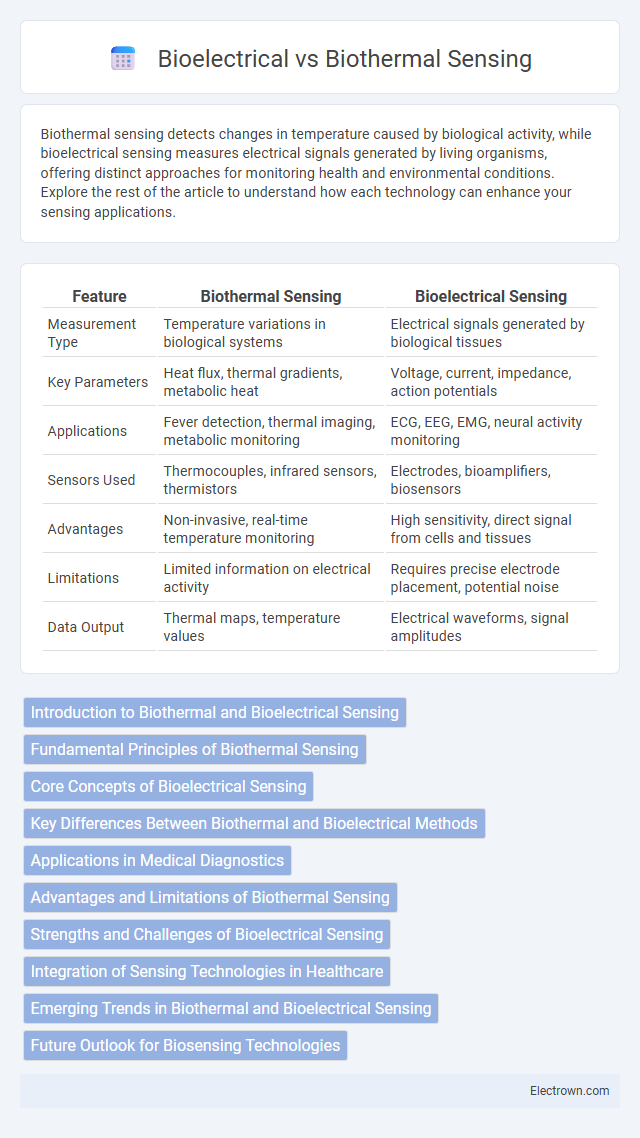Biothermal sensing detects changes in temperature caused by biological activity, while bioelectrical sensing measures electrical signals generated by living organisms, offering distinct approaches for monitoring health and environmental conditions. Explore the rest of the article to understand how each technology can enhance your sensing applications.
Table of Comparison
| Feature | Biothermal Sensing | Bioelectrical Sensing |
|---|---|---|
| Measurement Type | Temperature variations in biological systems | Electrical signals generated by biological tissues |
| Key Parameters | Heat flux, thermal gradients, metabolic heat | Voltage, current, impedance, action potentials |
| Applications | Fever detection, thermal imaging, metabolic monitoring | ECG, EEG, EMG, neural activity monitoring |
| Sensors Used | Thermocouples, infrared sensors, thermistors | Electrodes, bioamplifiers, biosensors |
| Advantages | Non-invasive, real-time temperature monitoring | High sensitivity, direct signal from cells and tissues |
| Limitations | Limited information on electrical activity | Requires precise electrode placement, potential noise |
| Data Output | Thermal maps, temperature values | Electrical waveforms, signal amplitudes |
Introduction to Biothermal and Bioelectrical Sensing
Biothermal sensing detects temperature changes in biological systems by measuring heat variations associated with metabolic processes, offering critical insights into cellular activity and physiological states. Bioelectrical sensing involves capturing electrical signals generated by biological tissues, such as nerve impulses or muscle activity, to monitor and interpret functional health information. Understanding these distinct sensing techniques enables you to select appropriate methods for applications ranging from medical diagnostics to environmental monitoring.
Fundamental Principles of Biothermal Sensing
Biothermal sensing operates on the fundamental principle of detecting temperature variations caused by metabolic or biochemical processes within biological systems. This technique measures the infrared radiation emitted by living tissues to monitor physiological changes accurately. Your ability to analyze these thermal signatures enables precise health diagnostics and real-time monitoring of biological functions.
Core Concepts of Bioelectrical Sensing
Bioelectrical sensing involves detecting and measuring electrical signals generated by biological systems, such as nerve impulses and muscle activity. These sensors utilize electrodes to capture bioelectric potentials, converting physiological electrical activity into readable data for diagnostics or monitoring. Unlike biothermal sensing, which measures heat variations in tissues, bioelectrical sensing provides real-time insights into cellular or neural functions through electrical signal analysis.
Key Differences Between Biothermal and Bioelectrical Methods
Biothermal sensing primarily measures temperature variations in biological tissues to detect physiological changes, whereas bioelectrical sensing assesses electrical signals generated by cellular activities such as nerve impulses or muscle contractions. Biothermal methods utilize thermal sensors like thermocouples and infrared detectors, while bioelectrical techniques employ electrodes to capture signals such as electrocardiograms (ECG) and electroencephalograms (EEG). The key differences lie in their signal type, applications, and sensitivity, with biothermal focusing on heat-related responses and bioelectrical on electrical activity for diagnostics and monitoring.
Applications in Medical Diagnostics
Biothermal sensing detects temperature variations in the human body to identify inflammation, infections, and abnormal tissue metabolism, aiding in early diagnosis of conditions like cancer and cardiovascular diseases. Bioelectrical sensing measures electrical signals such as ECG, EEG, and EMG to monitor heart rhythm, brain activity, and muscle function, crucial for diagnosing arrhythmias, epilepsy, and neuromuscular disorders. Combining biothermal and bioelectrical data enhances diagnostic accuracy in medical applications such as wearable health devices, remote patient monitoring, and personalized treatment plans.
Advantages and Limitations of Biothermal Sensing
Biothermal sensing offers the advantage of detecting physiological changes through temperature variations, enabling non-invasive monitoring of metabolic and vascular activities with high sensitivity. However, its limitations include susceptibility to external environmental factors such as ambient temperature fluctuations and skin surface conditions, which can affect accuracy and consistency. You should consider these factors when choosing biothermal sensors for applications requiring precise and reliable thermal data.
Strengths and Challenges of Bioelectrical Sensing
Bioelectrical sensing excels in real-time monitoring of physiological signals such as electrocardiograms (ECG) and electromyograms (EMG) due to its high sensitivity and non-invasive nature. The technology faces challenges including susceptibility to electrical noise interference and the need for precise electrode placement to ensure accurate data acquisition. Advances in signal processing techniques and flexible electrode materials are continually addressing these limitations to improve reliability and user comfort.
Integration of Sensing Technologies in Healthcare
Biothermal and bioelectrical sensing technologies enhance healthcare by providing complementary diagnostic data, where biothermal sensors detect temperature variations linked to physiological conditions and bioelectrical sensors monitor electrical signals such as heart rate and nerve activity. Integrating these technologies within wearable devices enables continuous, real-time health monitoring, improving patient outcomes through early detection of anomalies and personalized treatment plans. Advanced data fusion algorithms combine biothermal and bioelectrical inputs to deliver comprehensive insights into patient health status, facilitating more accurate diagnostics and remote healthcare management.
Emerging Trends in Biothermal and Bioelectrical Sensing
Emerging trends in biothermal sensing highlight advancements in wearable technology that monitor body temperature with enhanced accuracy and real-time data analytics, crucial for personalized health management. Bioelectrical sensing innovations concentrate on improved electrode materials and wireless integration, enabling non-invasive monitoring of electrical signals such as ECG and EEG for early disease detection. Your healthcare solutions increasingly benefit from the convergence of these technologies, offering comprehensive biometric insights for proactive wellness monitoring.
Future Outlook for Biosensing Technologies
Biothermal and bioelectrical sensing technologies are poised to revolutionize healthcare diagnostics by offering highly sensitive, real-time monitoring of physiological and biochemical parameters. Advances in nanomaterials and artificial intelligence integration are enhancing the precision and scalability of these biosensors, enabling personalized health management and early disease detection. Your access to continuous, non-invasive biosensing devices will drive improved patient outcomes and transform preventive medicine in the coming decade.
Biothermal vs Bioelectrical Sensing Infographic

 electrown.com
electrown.com